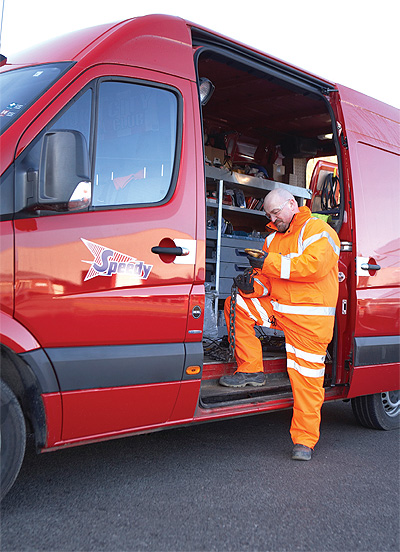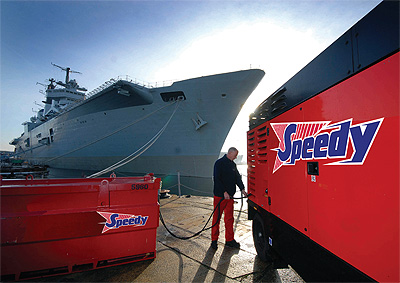Speedy Services
Speedy Services was established in 1975, formed out of a number of small tool and equipment depots based in the North-West of England.
The new agenda
Speedy Services was established in 1975, formed out of a number of small tool and equipment depots based in the North-West of England. By 2000 it had grown to an £80 million organisation with 70-80 small depots, and 14 years later its revenues exceed £350 million, with over 240 operational sites across the UK encompassing trading centres, as well as asset repair centres
 Our UK wide network will be supported from our national distribution centre, located in Tamworth in the Midlands from March next year. From there we will feed our network of multi-service centres, which are big multi-disciplinary engineering hubs where our equipment will be liveried, tested, repaired and stored ready for dispatch, and then distributed across our superstores, which range all the way from the north of Scotland down to the south coast, and in between that we have another 160 outlets which are pick up and collection points for our customers,” explains Mark Rogerson, CEO.
Our UK wide network will be supported from our national distribution centre, located in Tamworth in the Midlands from March next year. From there we will feed our network of multi-service centres, which are big multi-disciplinary engineering hubs where our equipment will be liveried, tested, repaired and stored ready for dispatch, and then distributed across our superstores, which range all the way from the north of Scotland down to the south coast, and in between that we have another 160 outlets which are pick up and collection points for our customers,” explains Mark Rogerson, CEO.
Employing a workforce of 3500 staff, the organisation holds nearly four and half million itemised assets with a net book value of £225 million. Every year the company distributes in the region of 50 million assets to its customer base of 65,000 ranging from the large strategic customers right through to the individual undertaking a DIY project. “With such a broad range of customers, our business has matured with a high degree of flexibility and understanding. For some of our customers operating round the clock, such as those involved across power networks we provide support 24/7, with equipment available on demand,” points out Mark.
The organisation also operates a consumables sales business, complementing the products offered for hire, supplying a whjole range of products including personal protective equipment (PPE), cutting disks and or lighting materials. The third package offered by Speedy Services is known within the business as the ‘broader services offering’ where it works continuously with its customers to deliver safety and environmental training of different types, undertakes testing, repairs, inspection and maintenance of equipment as well as providing, to strategic clients, supervisor and management training courses; an aspect that has increasingly grown with customers outsourcing the training of their staff to Speedy Services.
“We have three sets of customers, strategic, major and regional or local. Our strategic customers are major infrastructure and construction organisations such as Balfour Beatty, Costain and Carillion. Our major customers are the next tier of contractors that operate in those markets, and our regional customers include local builders, plumbers and general trades that need our equipment. Over the last 12 months I have seen a significant upturn in the market, particularly in London where growth in demand is up year-on-year and it is looking increasingly encouraging across other regions where the infrastructure plan is starting to take effect,” says Mark.
With a defined vision for the company, Mark entered the business in his newly appointed role as CEO, clearly articulating his targets: “My first aim is to ensure that we retain our market leading position and we are constantly striving to bring new and innovative products to market, which improve and enhance the safety and environment of our customers.” Indicating the desire to remain at the forefront of safety innovation, Speedy has been trialling and demonstrating to its customers new advanced technology in dust management, which by many is viewed as the new danger replacing the once unaddressed asbestos issue. “My second aim addresses service excellence and I see a real gap in the market and our industry for driving top quality service. The industry still has some way to go to achieve absolute assured delivery to our customers, all day, every day so that is at the top of my agenda. I come from a services background so service excellence to me is critical and to be able to guarantee that people see the equ pment that they want, on their site, when they want it, at the price that we promised them to a condition that is worthy of the high safety standards and productivity standards is of prime importance,” he adds.
Recognising that the efficiency of the business has a natural knock-on effect and impact on its customers, Mark’s third focus is, as he explains: “Really driving the efficiency agenda and making sure that we are absolutely optimising the utilisation of our assets and driving down the cost of our operation in terms of time and cost on logistics and property footprint, ensuring that we have the ability to distribute our assets much more effectively, track them, buy them, and dispose of them at the optimum point. The fourth strand of the vision surrounds people, and driving an agenda to bring in more people with more experience diversity from outside the industry, bringing techniques, ideas and thinking that transcends our industry. So we are after the best logisticians in the country, the best e-commerce practitioners, the best service operators, and I have really started that in the top 60 of the leadership team where we are now breaking new ground on the type of people that are taking the business forward.”
Delivering solutions across a wide scope of industries, each with varying requirements, Speedy’s success is very much dependant on its structure and its network of suppliers to ensure that it has the right equipment for the future. “It is about maintaining a close relationship and engagement with customers and ensuring that we are at the very forefront of our customers’ bidding pipelines. The one thing that differentiates Speedy in the market is the breadth and depth of the product holding, none of our competitors have the range and depth of the products that we hold. We stock up to 6000 different products, referenced into product categories, highlighting specialists in each section.
“Our suppliers are at the forefront of thinking, developing the latest technology, and through talking to the customers, we have a clear understanding of their demands. In many situations we actually lead the industry by bringing new products to our customers rather than reacting to demands to develop new solutions. Once our customers show an interest in the new product ranges we can make the right buying decisions at the right time whilst disposing of the older technology. As long as you have the right products coming from the manufacturer and suppliers, we can very quickly can see whether the customer has interest in those and we are able to buy at that point rather than having to take major risks of buying equipment without actually knowing what the customer wants,” highlights Mark.
When Mark first entered the sector, he quickly noticed that there was a high volume of innovation coming through the supply chain. The real challenge, he questioned, was how to capture that and make sure the right innovations and products are brought in, whilst conveying a message that is understood by the customer. “There is huge potential for us if we get that right. We are already thinking about establishing a new innovation centre for Speedy. That centre will focus on R&D and product innovation and will be a focal point and a shop window for our customers to see the innovation that we are driving into the market,” says Mark. Although undecided at this stage, the centre is likely to be developed at the new national distribution hub in Tamworth where the storage, distribution and training centres are also located.
 The organisation has been built on an infrastructure that is well suited to meet customer demands. The equipment it stocks for supply is mission critical, whether the customer is a small builder finishing off a house renovation or an infrastructure company engineering a large scale project such as the Thames Tideway Tunnels. “You need to make sure that you have an infrastructure and people delivery solution that gets the equipment to the customer at the right place at the right time. Two factors are vital in achieving this. Firstly that you have enough equipment and secondly, that you are able to dispatch it and distribute it quickly. The speed at which we turn our equipment round is absolutely critical, as is the speed at which we procure new equipment when we see there is a need for it. That commitment to be responsive to our customers needs is absolutely vital.
The organisation has been built on an infrastructure that is well suited to meet customer demands. The equipment it stocks for supply is mission critical, whether the customer is a small builder finishing off a house renovation or an infrastructure company engineering a large scale project such as the Thames Tideway Tunnels. “You need to make sure that you have an infrastructure and people delivery solution that gets the equipment to the customer at the right place at the right time. Two factors are vital in achieving this. Firstly that you have enough equipment and secondly, that you are able to dispatch it and distribute it quickly. The speed at which we turn our equipment round is absolutely critical, as is the speed at which we procure new equipment when we see there is a need for it. That commitment to be responsive to our customers needs is absolutely vital.
“We have been actively reconfiguring and modernising our network, and the biggest challenge is being sure to maintain the most streamlined, engineering support function in house, targeting the capability to turn the equipment around quickly. The industry hasn’t necessarily embraced lean engineering as well as it could have so focusing on the best strategy to get the most out of the logistics footprint whilst lowering the carbon impact of the business are all considerations as we develop the company. We are also a very high volume organisation, in terms of assets and also in terms of invoices and the challenge that we have now is how do to truly improve that and get it to a very high level of optimisation. Although it is a challenge, it is also a massive opportunity because if you get it right it has substantial cost implications,” highlights Mark.
For the first time in a number it is specifically targeting a large number of conurbations where it can offer customers a strong service and ensure that they understand the product range and the service offering available. Commenting on the programme, Mark says: “Through this drive we are really seeing an opportunity starting to emerge in regional areas such as Manchester, Liverpool, Birmingham, Oxford and Bristol, as well as many others. The other area of opportunity is to really modernise the sales channels that we see in other parts of the world such as e-commerce and making the ordering and fulfilment experience of our customers much stronger, and from both our ‘own-city’ campaign and e-commerce, we will start to see real capability and maturity of our offering start to evolve.”
The recovery from the issues that the organisation suffered from in the Middle East is well under way, and although it is not fully complete, it is noticeable that the new management team and structure is really bringing reinvigoration to the brand. Looking ahead to a much brighter future, Mark concludes on the prospects for the business that will ultimately benefit the whole industry: “The real prize is to truly optimise Speedy as a business engine, whether that is our own back office processing, our logistics capability or the way that we manage and optimise our assets. That is the first journey for us, and one that we are already progressing with. If we are able to get all that right then our service excellence levels improve hugely and therefore our customer advocacy is quite significant. I want to take the business to the next level of maturity in business optimisation efficiency and that is fundamentally the number one goal.
“Our several thousand strong customer-base spends a lot of money on complementary services, and these are all options that I think Speedy Services can now offer such as training, environmental consultancy, site set up and security on big projects. All of our customers are incredibly health conscious and driven by environmental and efficiency considerations and what we have got to do is make sure that we are maximising that opportunity. We are in a position to introduce new additional services to suit their needs and if we can capture that and get that right then the company will quickly reach the next level of success.”